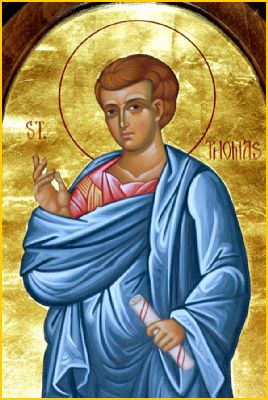|
One of the Twelve Apostles, he was a Galilean by birth. His name means “twin.” The twentieth chapter of St John’s Gospel describes how, when he doubted the appearance of the Risen Lord, Christ appeared to him again, saying “Reach hither thy hand, and thrust it into my side; and be not faithless, but believing,” at which Thomas cried out “My Lord and my God. Through this one event the Holy Scriptures attest that Christ is risen bodily, not merely as a spirit, as some heresies claim; and that He is in fact God. After Pentecost, St Thomas proclaimed the Gospel in the East, and established the Christian faith as far as India, where the small remnant of the ancient Church still traces its foundation to him. According to some accounts he met a martyr’s end; according to others, he reposed in peace. St John Chrysostom mentions that his tomb was in Edessa in Syria; his relics may have been translated there from India in the fourth century. |
|
The Holy and Glorious Apostle Thomas was born in the Galileian city of Pansada and was a fisherman. Hearing the good tidings of Jesus Christ, he left all and followed after Him. The Apostle Thomas is included in the number of the holy Twelve Apostles of the Savior.
According to Holy Scripture, the holy Apostle Thomas did not believe the reports of the other disciples about the Resurrection of Jesus Christ: “Unless I see in His hands the print of the nails, and put my finger into the print of the nails, and thrust my hand into His side, I will not believe” (John 20:25). On the eighth day after the Resurrection, the Lord appeared to the Apostle Thomas and showed him His wounds. “My Lord and my God,” the Apostle cried out (John 20:28). “Thomas, being once weaker in faith than the other apostles,” says St John Chrysostom, “toiled through the grace of God more bravely, more zealously and tirelessly than them all, so that he went preaching over nearly all the earth, not fearing to proclaim the Word of God to savage nations.” Some icons depicting this event are inscribed “The Doubting Thomas.” This is incorrect. In Greek, the inscription reads, “The Touching of Thomas.” In Slavonic, it says, “The Belief of Thomas.” When St Thomas touched the Life-giving side of the Lord, he no longer had any doubts. According to Church Tradition, the holy Apostle Thomas founded Christian churches in Palestine, Mesopotamia, Parthia, Ethiopia and India. Preaching the Gospel earned him a martyr’s death. For having converted the wife and son of the prefect of the Indian city of Meliapur [Melipur], the holy apostle was locked up in prison, suffered torture, and finally, pierced with five spears, he departed to the Lord. Part of the relics of the holy Apostle Thomas are in India, in Hungary and on Mt. Athos. The name of the Apostle Thomas is associated with the Arabian (or Arapet) Icon of the Mother of God (September 6). |

















